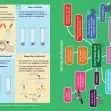


KS4 / GCSE Biology – Enzymes
✅ Learn or revise complicated concepts easily
✅ Information broken down into short chunks
✅ Full-colour illustrations on every page
Understanding how enzymes work is essential in order to understand biology at GCSE. This revision pack makes learning the core information quick and simple.
Broken down into bite sized chunks, this Enzymes GCSE revision guide will help students understand (and remember!) the key facts about enzymes: how they work, why they are important and how they can be damaged.
Each numbered section is clearly laid out and illustrated to aid understanding, making it more accessible to all students, irrespective of their reading ability, with beautiful images to highlight each key point.
Written by Stuart Lawes, former Head of Science and a science tutor for CE, GCSE and ‘A’ level students for over 20 years, the Enzymes revision pack brings GCSE revision to life in a visual and highly memorable way, identifying tricky concepts and translating them into easy to understand sections.
Topics Covered Include:
Glossary of keywords
Understanding chemical reactions and catalysts
Enzymes and proteins
Shapes and bonds in amino acids
The effect of temperature and change of pH on enzymes
Active sites and Lock & Key Theory
Digestive enzymes
Inhibitors and how they affect enzyme action
How our bodies control enzymes
Faster reactions and optimum temperatures
Denatured enzymes
Enzyme concentration and activity graphs
Practical: the effect of temperature on enzymes
Practical: the effect of pH on enzymes
Plus, the Topic Pack contains 41 active learning questions & answer flashcards!
About GCSE Enzymes
Enzymes are proteins that act as catalysts, which means they speed up chemical reactions in living organisms. Think of enzymes as helpers that make things happen faster and more efficiently.
These intriguing proteins are made from amino acids and are used in many different processes in the body, such as digestion, metabolism, and the production of energy. Without enzymes, many of these processes would happen much slower or not at all, which would affect the overall functioning of the body.
Enzymes are specific, meaning they only work with specific substances or chemicals. This specificity allows enzymes to work in specific ways and helps ensure that the right reactions happen in the right places in the body.
Active Sites and Lock & Key Theory
Enzymes ‘slot it’ to other molecules. The active site of an enzyme is the region on the enzyme where a substrate molecule binds and undergoes a reaction. The active site has a specific shape and chemical composition that is complementary to the shape and composition of the substrate molecule.
The “Lock and Key” theory is a model that explains how enzymes and substrates interact with each other. Here, the active site of the enzyme is like a lock, and the substrate molecule is like a key. The key fits perfectly into the lock, allowing the reaction to occur. When the reaction is complete, the product molecule is released, and the enzyme is ready to bind to another substrate molecule.
This theory highlights the specificity of enzyme-substrate interactions and explains why enzymes can only catalyze specific reactions. The shape and chemical composition of the active site of an enzyme is unique and allows it to interact specifically with its target substrate molecule. If a substrate molecule does not fit the shape of the active site, the reaction will not occur. An understanding of Lock and Key Theory is important for GCSE enzymes.
WHAT'S IN EACH PACK
- Topic Booklet
- Write Your Own Notes Booklet
- Active Learning Q&A Flashcards









